publications
in reversed chronological order.
2025
-
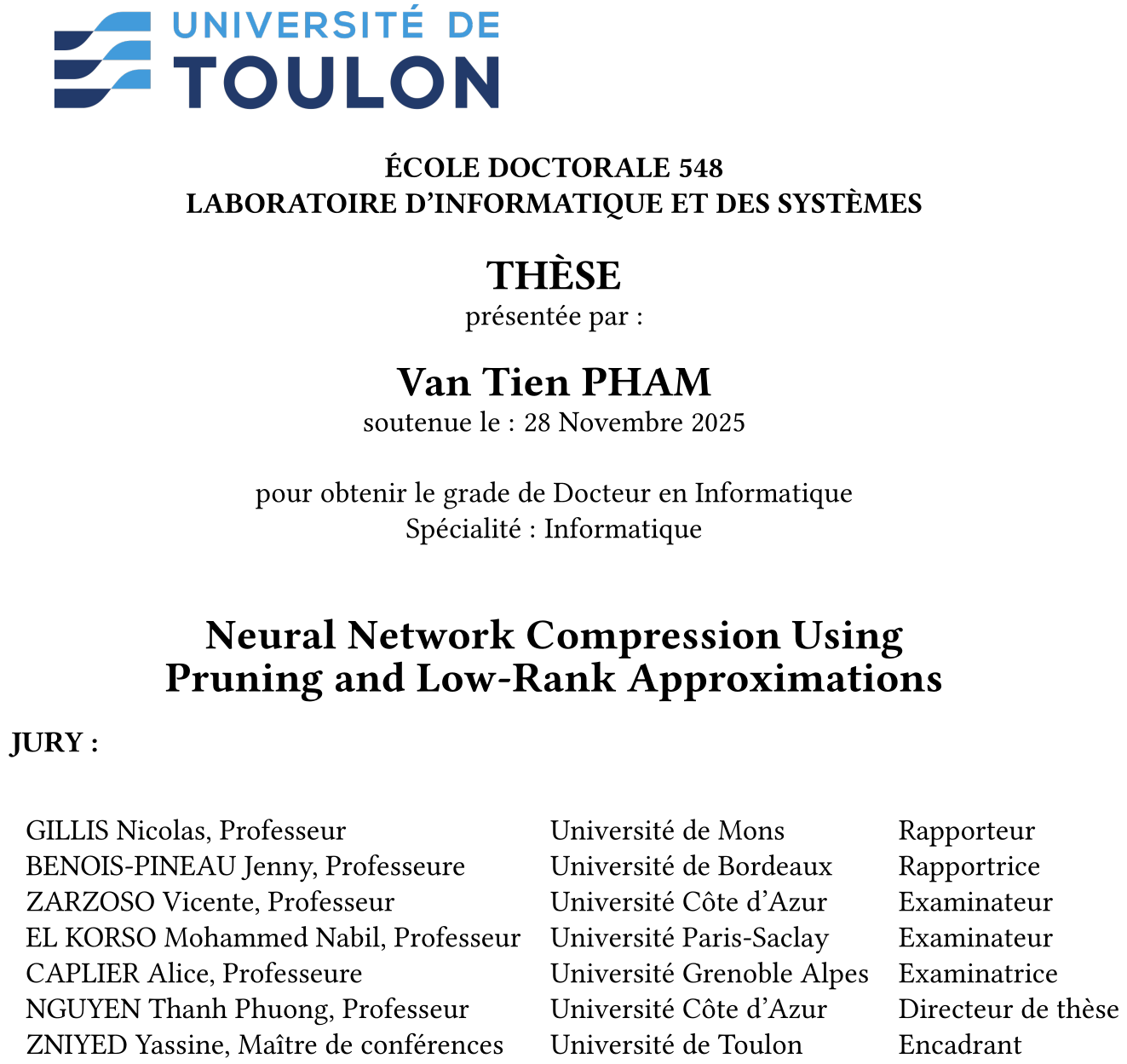 Neural Network Compression Using Pruning and Low-Rank ApproximationsVan Tien PhamUniversité de Toulon, 2025
Neural Network Compression Using Pruning and Low-Rank ApproximationsVan Tien PhamUniversité de Toulon, 2025This thesis introduces five methods for neural network compression, focusing on pruning and low-rank approximations. First, CORING (effiCient tensOr decompositionbased filteR prunING) is an efficient pruning method that uses higher-order singular value decomposition to preserve the tensorial structure of convolutional filters, enabling effective low-rank approximations. Second, SLIMING (Singular vaLues-drIven autoMated filter prunING) is a singular value-driven framework that formulates pruning as a two-stage optimization problem, where both configuration and filter selection are guided by spectral properties. Third, NORTON (enhanced Network cOmpRession through TensOr decompositions and pruNing) is a hybrid approach that leverages the advantages of both tensor decomposition and structured pruning. Fourth, CoDeC (Coupled tensor Decomposition for Compact network representation) employs coupled canonical polyadic decomposition to jointly factorize groups of similar filters, with a custom similarity metric used for pre-clustering. Finally, . Together, these contributions offer complementary and principled strategies to reduce model complexity while maintaining high performance across diverse neural architectures.
-
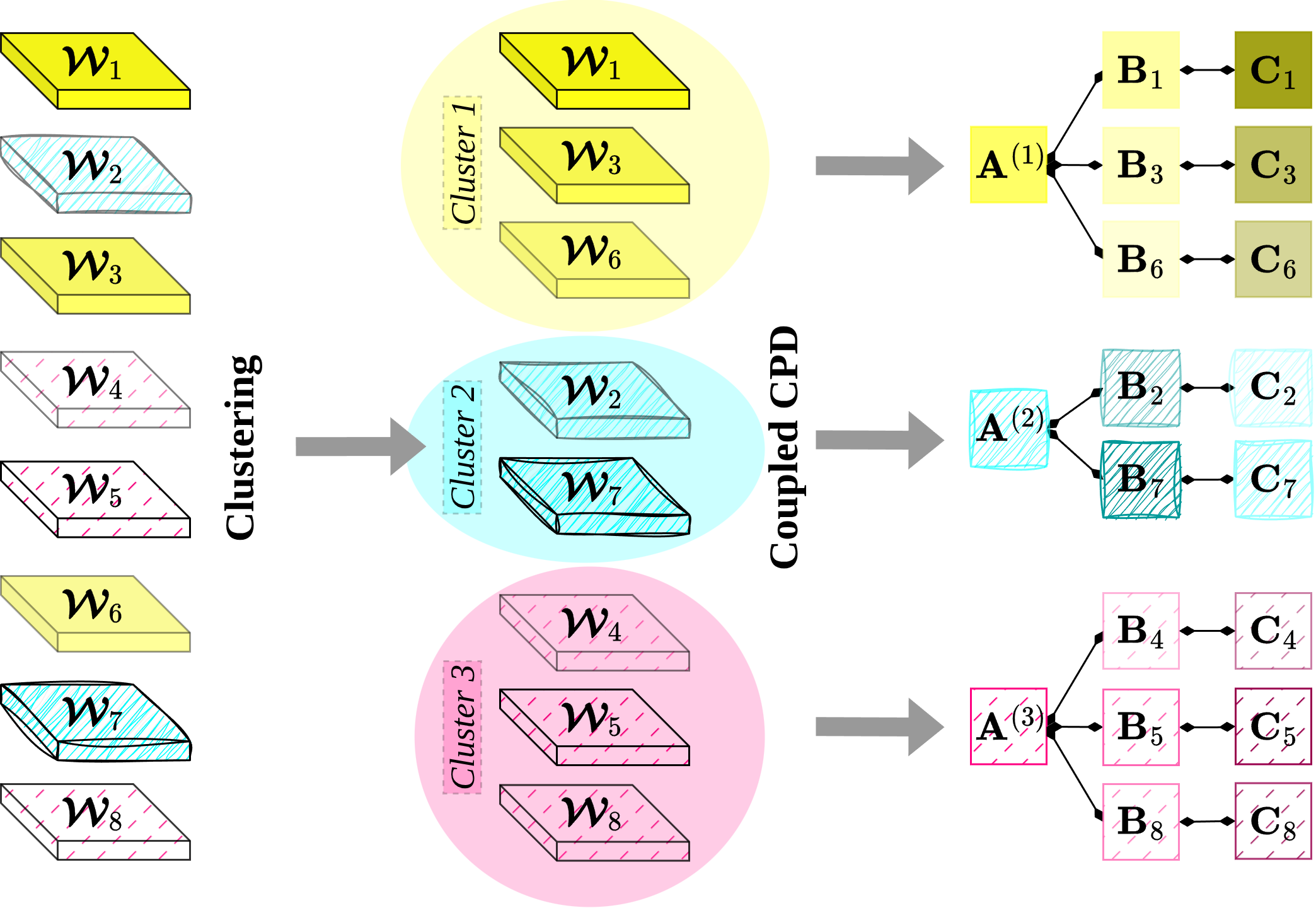 Coupled Tensor Decomposition for Compact Network RepresentationVan Tien Pham, Yassine Zniyed, and Thanh Phuong NguyenIEEE Transactions on Neural Networks and Learning Systems, 2025
Coupled Tensor Decomposition for Compact Network RepresentationVan Tien Pham, Yassine Zniyed, and Thanh Phuong NguyenIEEE Transactions on Neural Networks and Learning Systems, 2025In this paper, we introduce an approach called coupled filters decomposition, which builds on the key observation that redundancy exists among filters within a convolutional layer, meaning that similar filters can produce partially overlapping outputs. Leveraging this insight, we propose a joint decomposition of filters using coupled tensor decompositions, specifically coupled canonical polyadic decomposition, which enables the sharing of a common factor matrix across similar filters. This joint factorization not only reduces the number of parameters but also lowers computational complexity by eliminating redundant computations. To further enhance the efficiency of our approach, we first cluster the filters (prior to decomposition) into groups that are better suited for coupled decomposition—where the coupling constraint is less restrictive—using a custom metric based on the shared mode subspace. Extensive experiments across various architectures, datasets, and tasks validate the effectiveness of our method, demonstrating its competitive performance compared to state-of-the-art model compression techniques.
-
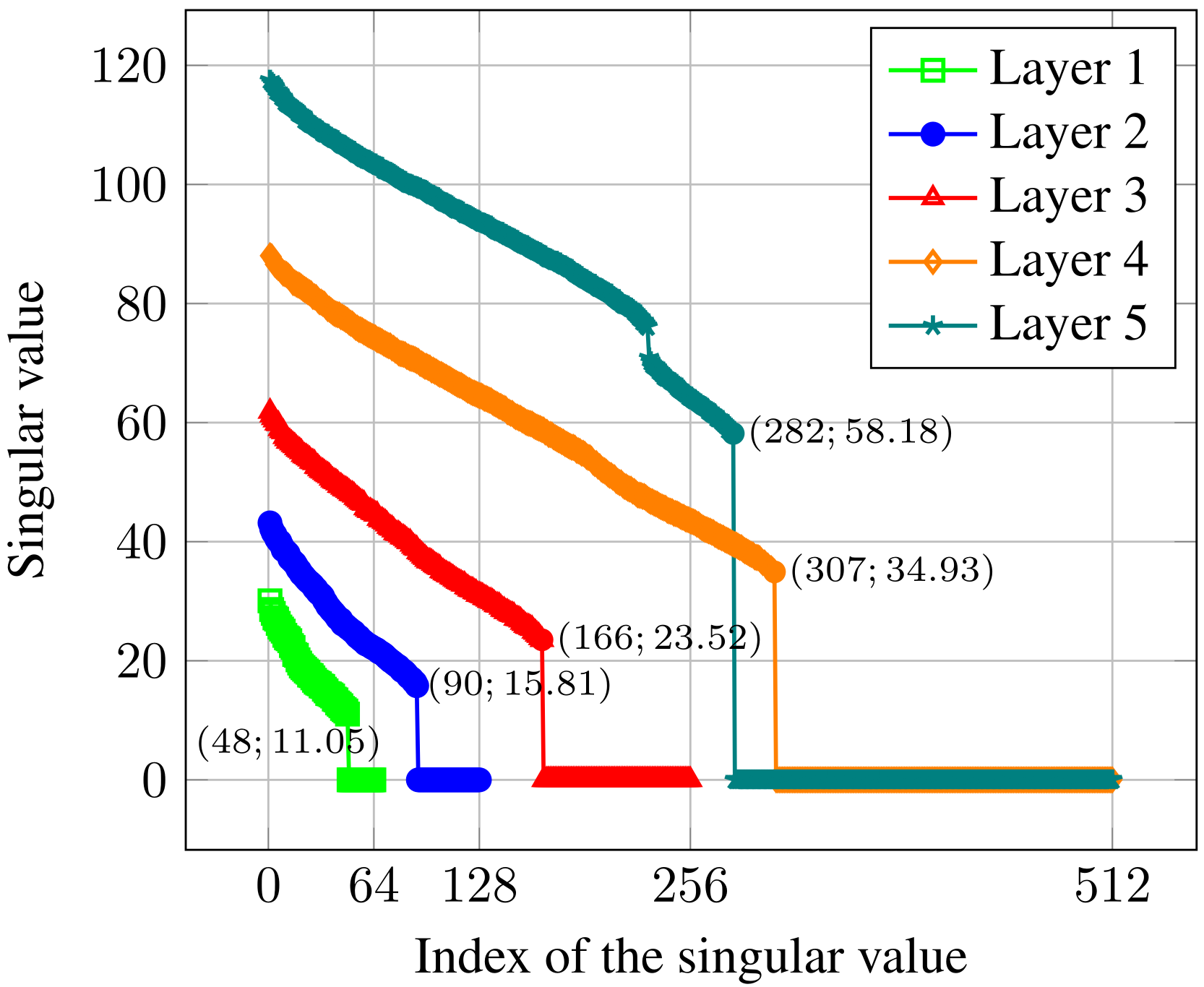 Singular values-driven automated filter pruningVan Tien Pham, Yassine Zniyed, and Thanh Phuong NguyenNeural Networks, 2025
Singular values-driven automated filter pruningVan Tien Pham, Yassine Zniyed, and Thanh Phuong NguyenNeural Networks, 2025In this paper, we present SLIMING (Singular vaLues-drIven autoMated filter prunING), an automated filter pruning method that uses singular values to formalize the pruning process as an optimization problem over filter tensors. Recognizing that this original formulation poses a combinatorial challenge, we propose to replace it with a two-step process that consistently uses singular values in each phase: (i) determining the pruning configuration, which specifies the number of filters to retain in each layer, and (ii) selecting the filters themselves. We show that this approach ensures the preservation of the filters’ multidimensional structure throughout the pruning process. For each of these steps, we propose a straightforward algorithm to solve them. To validate each part of our approach, we performed a numerical simulation on an overparameterized synthetic toy example. Additionally, we conducted extensive simulations across eight architectures, four benchmark datasets, and four vision tasks, validating the efficacy of our framework.
-
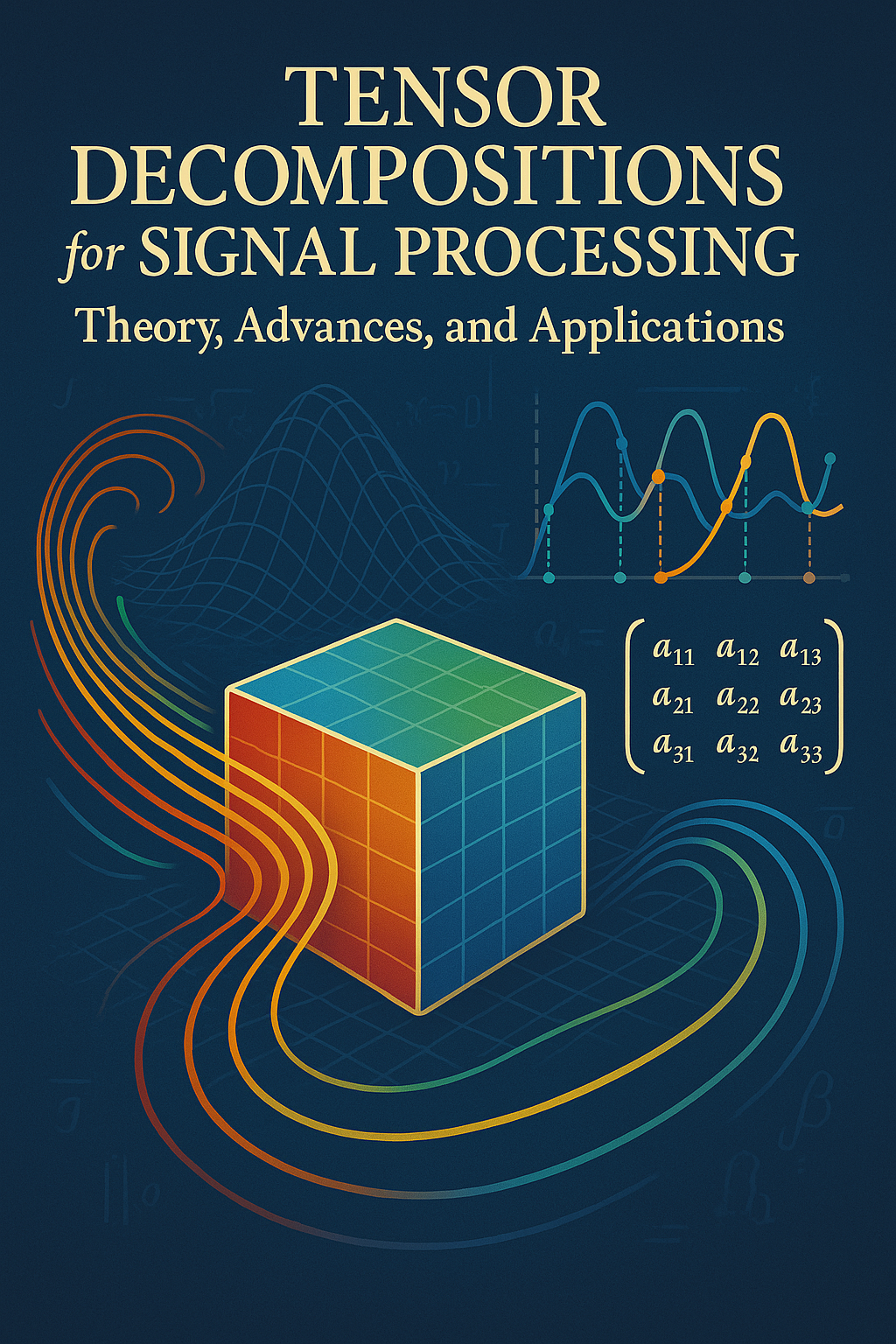 Tensor Decompositions for Signal Processing: Theory, Advances, and ApplicationsNeriman Tokcan, Shakir Showkat Sofi, Van Tien Pham, Clémence Prévost, Sofiane Kharbech, Magnier Baptiste, Thanh Phuong Nguyen, Amirhamzeh Khoshnam, Yassine Zniyed, and Lieven De LathauwerSignal Processing, 2025
Tensor Decompositions for Signal Processing: Theory, Advances, and ApplicationsNeriman Tokcan, Shakir Showkat Sofi, Van Tien Pham, Clémence Prévost, Sofiane Kharbech, Magnier Baptiste, Thanh Phuong Nguyen, Amirhamzeh Khoshnam, Yassine Zniyed, and Lieven De LathauwerSignal Processing, 2025In the era of big data, rapid advancements in technology and data collection methods have led to the generation of vast amounts of multi-modal high-dimensional data across a diverse range of disciplines. Tensor methods have emerged as essential tools in signal processing, providing powerful frameworks to analyze such complex data effectively. This survey offers a comprehensive overview of tensor factorization techniques and their applications. We explore their role in remote sensing, focusing on tensor-based methods for analyzing hyperspectral and multispectral images, tackling challenges such as recovering super-resolution images and addressing spectral unmixing. In wireless communication, we examine tensor methods used for signal modulation in unsourced massive random access communication. We also discuss tensor applications in network compression, where they reduce the computational demands of deep neural networks. Additionally, we highlight the use of tensor methods in high-dimensional missing data completion problems, showcasing their versatility across various domains. Furthermore, we explore applications in image analysis and computer vision, where tensors are effectively utilized for motion and object tracking, analysis of satellite imaging, and medical imaging. By bridging theoretical advancements with practical applications, this survey aims to guide researchers in leveraging tensor methods to tackle emerging challenges in signal processing.
2024
-
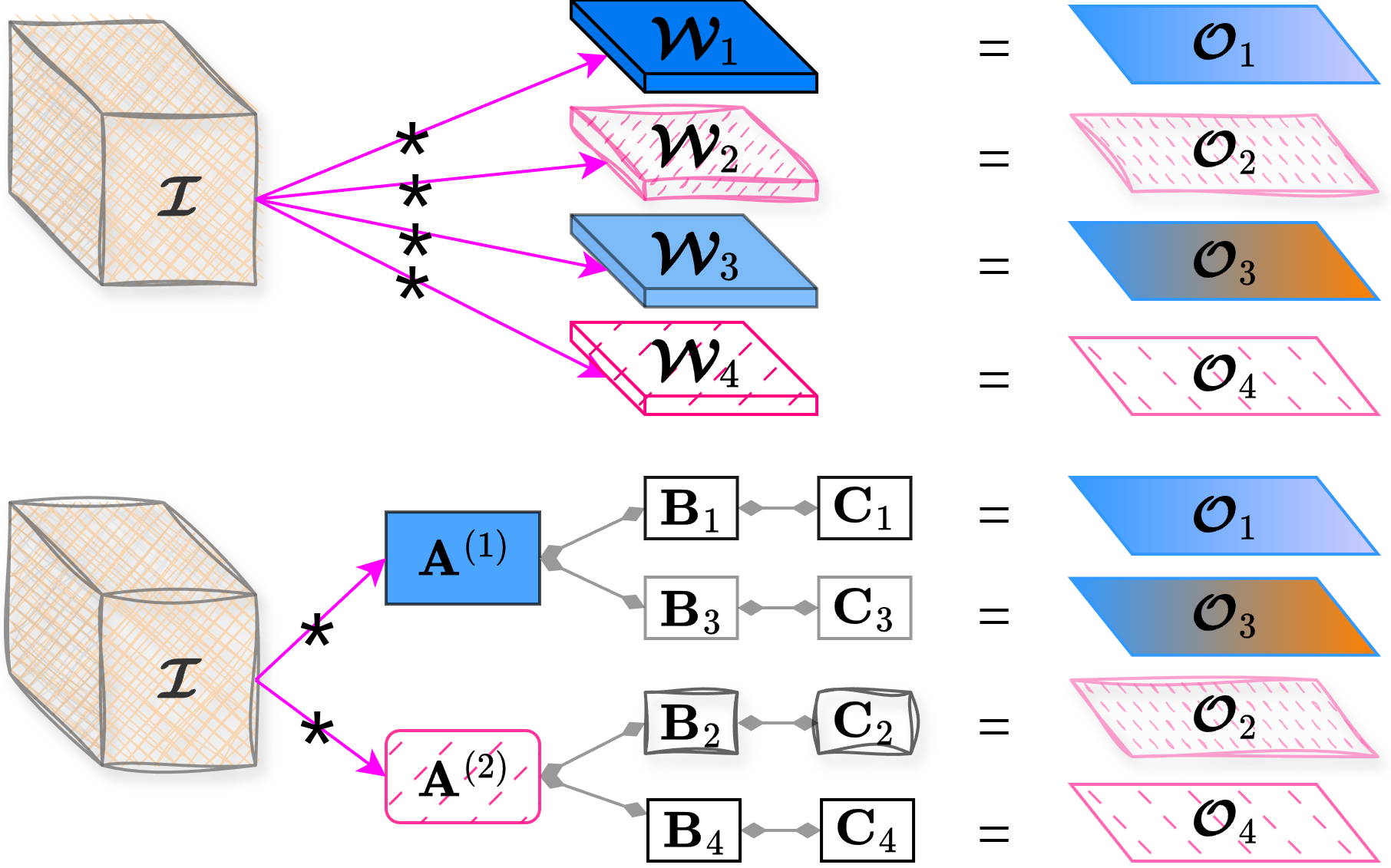 Deep Neural Networks Compression Using Low-Rank ApproximationsVan Tien PhamRapport de la deuxième année de thèse, soumis au Comité de Suivi Individuel, École Doctorale 548, Université de Toulon, 2024
Deep Neural Networks Compression Using Low-Rank ApproximationsVan Tien PhamRapport de la deuxième année de thèse, soumis au Comité de Suivi Individuel, École Doctorale 548, Université de Toulon, 2024This report updates the outcomes of the first year and outlines the progress made during the second year of my PhD. The manuscripts submitted from the two first-year projects, CORING and NORTON, are published in Neural Networks and IEEE Transactions on Neural Networks and Learning Systems, respectively. In the second year, I focused on two new projects, contributing to advancements in neural network compression and acceleration through filter pruning and tensor decomposition techniques. The first project led to the development of SLIMING (Singular vaLues-drIven autoMated prunING), an automated filter pruning method based on singular value analysis. SLIMING divides the pruning task into two stages: determining the pruning configuration and selecting the filters to prune for each layer. By formulating these as optimization problems, the method ensures the structural integrity of filters and has been validated through extensive experiments on various architectures and datasets. The second project introduced coupled filter decomposition, a novel low-rank approximation approach. By jointly factorizing filters using coupled tensor decompositions, specifically coupled Canonical Polyadic Decomposition (CCPD), we enable the sharing of a common factor matrix across filters, thereby significantly reducing both parameter count and computational complexity. A custom distance metric for K-means clustering further improves the grouping of similar filters, enhancing the overall compression performance. The approach was tested across multiple vision tasks, showing competitive results in model compression. Potential avenues include delving deeper into the low-rank approximation domain, expanding to encompass other techniques, exploring a broader spectrum of neural network architectures, and applying these efficient models to diverse applications.
-
 Efficient tensor decomposition-based filter pruningVan Tien Pham, Yassine Zniyed, and Thanh Phuong NguyenNeural Networks, 2024"One model to compress them all, one approach to refine efficiency,
Efficient tensor decomposition-based filter pruningVan Tien Pham, Yassine Zniyed, and Thanh Phuong NguyenNeural Networks, 2024"One model to compress them all, one approach to refine efficiency,
One method to decompose tensors and enhance neural proficiency.
In the realm of filters, CORING stands tall and true,
Preserving dimensions, accuracy it will accrue.
Experiments demonstrate its prowess, architectures put to test,
FLOPS and parameters reduced, accuracy manifest.
Like ResNet-50 in ImageNet’s vast domain,
Memory and computation requirements it does restrain.
Efficiency elevated, generalization takes its flight,
In the world of neural networks, C💍RING shines its light." -
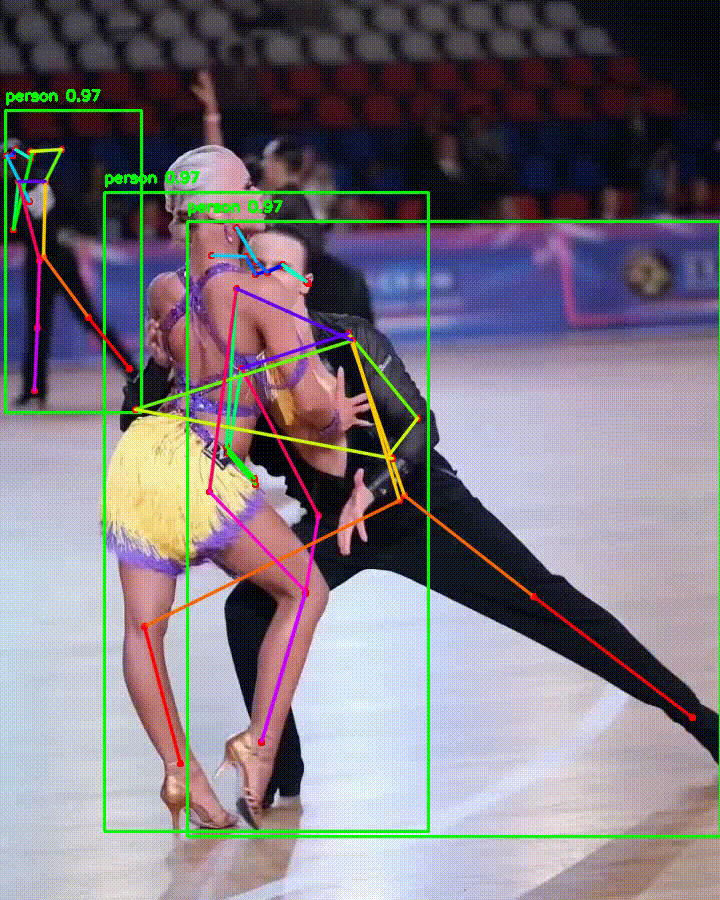 Enhanced Network Compression Through Tensor Decompositions and PruningVan Tien Pham, Yassine Zniyed, and Thanh Phuong NguyenIEEE Transactions on Neural Networks and Learning Systems, 2024
Enhanced Network Compression Through Tensor Decompositions and PruningVan Tien Pham, Yassine Zniyed, and Thanh Phuong NguyenIEEE Transactions on Neural Networks and Learning Systems, 2024Network compression techniques that combine tensor decompositions and pruning have shown promise in leveraging the advantages of both strategies. In this work, we propose enhanced Network cOmpRession through TensOr decompositions and pruNing (NORTON), a novel method for network compression. NORTON introduces the concept of filter decomposition, enabling a more detailed decomposition of the network while preserving the weight’s multidimensional properties. Our method incorporates a novel structured pruning approach, effectively integrating the decomposed model. Through extensive experiments on various architectures, benchmark datasets, and representative vision tasks, we demonstrate the usefulness of our method. NORTON achieves superior results compared to state-of-the-art (SOTA) techniques in terms of complexity and accuracy. Our code is also available for research purposes.
- Hybrid Network Compression through Tensor Decompositions and PruningVan Tien Pham, Yassine Zniyed, and Thanh Phuong NguyenIn 2024 32nd European Signal Processing Conference (EUSIPCO), 2024
The application of network compression methods, combining tensor decompositions and pruning, has demonstrated significant potential in harnessing the benefits of both strategies. This research introduces NORTON (hybrid Network cOmpression thRough Tensor decompOsitions and pruNing), a novel hybrid approach for network compression. The key innovation lies in the introduction of filter decomposition, enhancing the detailed breakdown of the network while preserving the multidimensional properties of filters. Our method incorporates a structured pruning approach, seamlessly integrating the decomposed model. Through a comprehensive set of experiments across various architectures, benchmark datasets, and representative vision tasks, the efficacy of our approach is highlighted.
2023
-
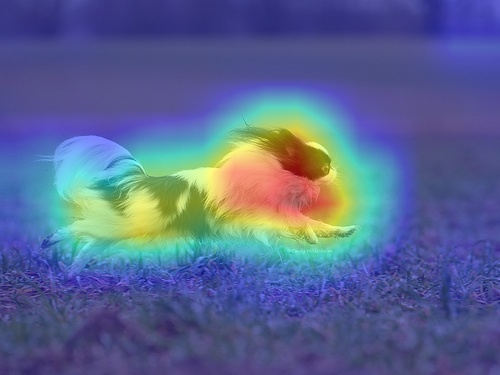 Deep Learning through Efficient Model DesignVan Tien PhamRapport de la première année de thèse, soumis au Comité de Suivi Individuel, École Doctorale 548, Université de Toulon, 2023
Deep Learning through Efficient Model DesignVan Tien PhamRapport de la première année de thèse, soumis au Comité de Suivi Individuel, École Doctorale 548, Université de Toulon, 2023In the rapidly evolving landscape of deep learning, the proliferation of large-scale neural networks has brought forth new horizons of artificial intelligence. However, their sheer size and computational demands have posed significant challenges, limiting their applicability in resource-constrained environments. The overarching problem of network compression seeks to mitigate these challenges by efficiently designing deep neural models. In this report, we embark on a journey to address this problem, exploring novel avenues for model compression. Our first contribution, CORING, introduces a pioneering filter pruning method that harnesses tensor decomposition, preserving the multidimensional essence of filters. By leveraging the power of CORING, we achieve impressive reductions in model size and computational requirements while retaining or even enhancing performance. CORING’s ability to generalize models through pruning is demonstrated across various architectures and datasets. The second contribution, NORTON, unveils a hybrid network compression technique that combines tensor decompositions with structured pruning. NORTON offers a comprehensive approach to model compression, optimizing architecture, and reducing the number of parameters. With NORTON, we attain superior compression ratios and accuracy retention, making it a versatile tool for model optimization. Looking ahead, our research sets the stage for future investigations. Potential avenues include delving deeper into the compression domain, expanding to encompass various decomposition techniques, exploring a broader spectrum of neural network architectures, and applying these efficient models to diverse applications. As we navigate the evolving landscape of deep learning, the pursuit of efficient model design remains at the forefront, driving innovation and unlocking the potential for AI in resource-constrained scenarios.
-
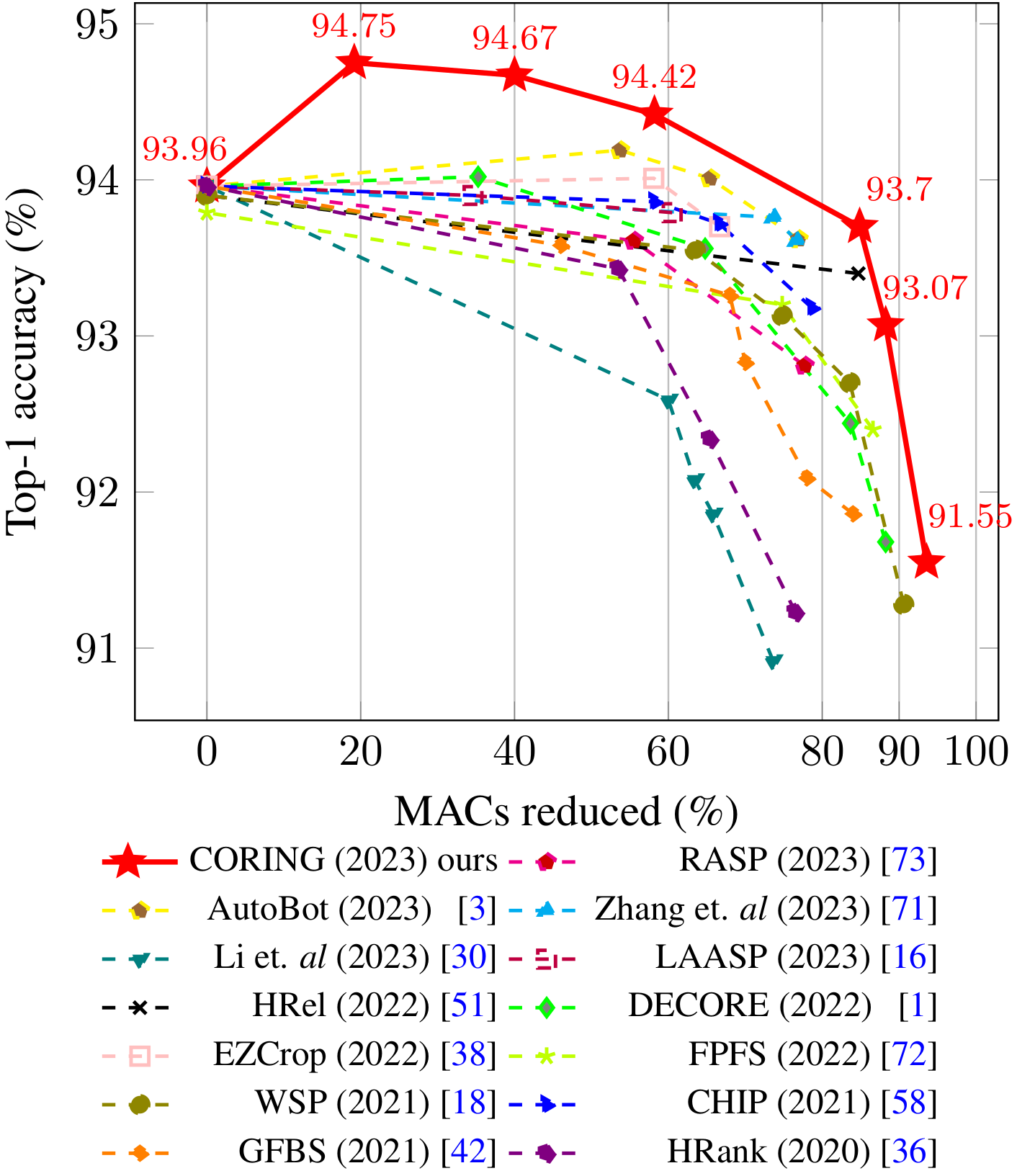 Élagage efficace des filtres basé sur les décompositions tensoriellesVan Tien Pham, Yassine Zniyed, and Thanh Phuong NguyenIn GRETSI 2023 XXIXème Colloque Francophone de Traitement du Signal et des Images, 2023
Élagage efficace des filtres basé sur les décompositions tensoriellesVan Tien Pham, Yassine Zniyed, and Thanh Phuong NguyenIn GRETSI 2023 XXIXème Colloque Francophone de Traitement du Signal et des Images, 2023Nous présentons une nouvelle méthode d’élagage des filtres pour les réseaux de neurones, appelée CORING (pour effiCient tensOr decomposition-based filteR prunING en anglais). L’approche proposée maintient l’aspect multidimensionnel des filtres grâce à l’utilisation de décompositions tensorielles. Notre approche permet de mesurer la similarité entre les filtres de manière plus efficace et plus précise que les méthodes traditionnelles qui utilisent des versions vectorisées ou matricisées des filtres. Avec cette approche, nous pouvons effectuer l’élagage des filtres plus efficacement en gardant l’essentiel de l’information en utilisant des décompositions de tenseurs sur les filtres. Les expériences menées sur différentes architectures prouvent l’efficacité de CORING.
2021
-
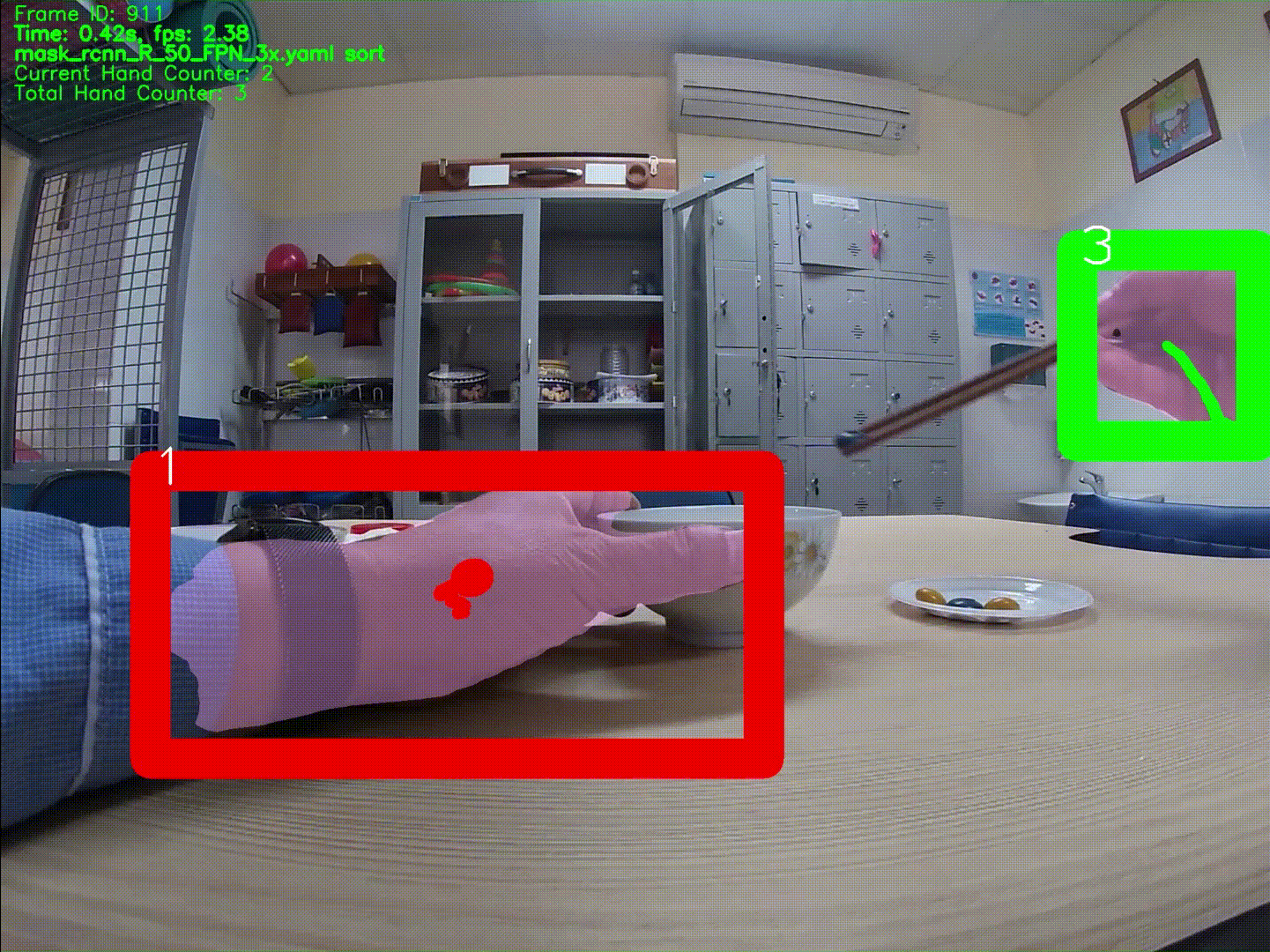 Detection and tracking hand from FPV: benchmarks and challenges on rehabilitation exercises datasetVan Tien Pham, Thanh Hai Tran, and Hai VuIn 2021 RIVF International Conference on Computing and Communication Technologies (RIVF), 2021
Detection and tracking hand from FPV: benchmarks and challenges on rehabilitation exercises datasetVan Tien Pham, Thanh Hai Tran, and Hai VuIn 2021 RIVF International Conference on Computing and Communication Technologies (RIVF), 2021Egocentric vision is an emerging field of computer vision characterized by the acquisition video from the first person perspective. Particularly, for evaluating upper extremity rehabilitation, egocentric vision offers the ability to quantitatively measure the function of hands used in physical-based exercises. For such applications, hand detection and tracking are the first requirement. In this work, we develop a fully automatic tracking by detection pipeline that firstly extracts hands positions and then tracks hands in consecutive frames. The proposed framework consists of state of the art detectors such as RCNN and YOLO family models coupled with advanced trackers (e.g., SORT and DeepSORT) for tracking task. This paper explores how performance of the stand alone object detection algorithms correlates with overall performance of a tracking by detection system. The experimental results show that detection highly impacts the overall performance. Moreover, this work also proves that the use of visual descriptors in the tracking stage can reduce the number of identity switches and thereby increase potential of the whole system. We also present challenges for new egocentric hand tracking dataset for future works.
